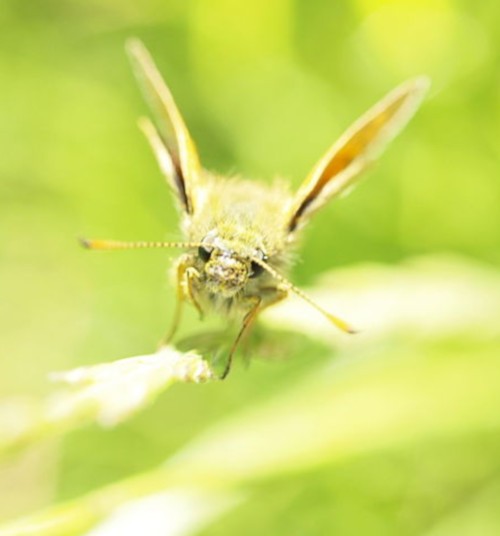
Meet her family below.
Rupa’s Family:
Meet the Lepidopterans. There are about 180,000 different kinds which are grouped according to their looks and behavior. Generally, their family is represented by the following three species. Can you identify from which one is Rupa?
I

Butterfly
Butterflies have long and thin antennae with bulbs at the end. They are active in the daytime. They hold their wings together when they are resting, just like Rupa on top. Most have colorful vibrant colors.

Moth
Moths generally have pointed and fern like antennae. They are active at night. Their wings are flat when resting. Most of them have drab colors but there are very colorful ones too. They have a “‘frenulum” on their wings

Skipper
Skippers have short or long thin antennae that are bent or hook like at the ends. They are diurnal. When resting, they turn their wings toward the sunlight. They fly in skipping patterns which is the origin of their name.
(please check Vocabularies after “Butterfly Parts” below)
Butterfly image by
Zeynel Cebeci, CC BY-SA 4.0, via Wikimedia Commons
Moth Image by Ian Lindsay from Pixabay
II
Lepidopterans’ Lifecycle:
Metamorphosis is the process of change that occur during the life time of some animals, like the beautiful butterfly.
Everyone started their life as an egg:



Monarch butterfly egg image by Lorie Shaull, CC BY-SA 2.0 via Wikimedia C
Polyphemus moth eggs image by Jacy Lucier, CC BY-SA 4.0 via Wikimedia Commons
Banana skipper eggs image by Dr. Raju Kasambe, CC BY-SA 4.0 , via Wikimedia Commons
They then hatched into very hungry caterpillars:



Monarch caterpillar image by Victor Korniyenko, CC BY-SA 3.0 via Wikimedia Commons
Red-humped caterpillar image by Anthony VanSchoor, CC BY-SA 4.0 via Wikimedia Commons
Mangrove skipper caterpillar by Bob Peterson, CC BY-SA 2.0 via Wikimedia Commons
When they cannot grow any bigger, they will turn into:



Monarch butterfly chrysalis’ image by davidd, CC BY 2.0 via Wikimedia Commons
silkworm cocoon’s image by butterflyarc from Pixabay
Golden Angle chrysalis’ image by Vinayaraj, CC BY-SA 4.0 via Wikimedia
The final stage of their transformation is when they become adults:


Hi! I’m moth

Hi! I’m skipper
Fritillary butterfly’s face image by Laura Åkerblom from Pixabay
Tussar moth’s face image by Yathumon M A, CC BY-SA 4.0, via Wikimedia Commons
Large skipper’s face image by Line Sabroe from Denmark, CC BY 2.0 via Wikimedia
The adults are now ready to have babies, a new life cycle will begin…
III
Butterfly Parts

- a pair of antennae – detect smell and wind speed
- they have 6 legs
- compound eyes – the big round eyes help them see on all sides even without moving them
- abdomen – is where their heart and other organs are located
- thorax – their wings and legs are attached here
- proboscis – they uncoil this and is like a straw they use to sip nectar or other liquid
- wing vein -are like tubes that give support to their wings
- eye spots – these can scare off their predators
a butterfly’s profile Image by StockSnap from Pixabay
Here is a closer look of their “straw” or Proboscis

a butterfly’s proboscis Image by DerWeg from Pixabay
Vocabularies:
- Diurnal – animals that are awake or active during the daytime
- Nocturnal – animals that are awake and active during the night
- Frenulum – connects the forewings and hindwings of moths together. They are like bristles or clips that link both wings.
- drab color – dull, light brown

